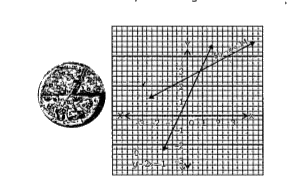If a linear equation has solutions (-2,2)(0,0) and (2,-2), then it is of the form
y-x=0
x+y=0
−2x+y=0
−x+2y=0
The correct Answer is:B
Let us consider a linear equation ax+by+c=0
Since, (−2),2), (0,0) and (2,-2) are the solutions of linear equation therefore it satisfies the Eq. (i), we get
At point (−2),2), −2a+2b+c=0
At point (0,0), 0+0+c=0⇒c=0
and at point (2,−2), 2a−2b+c=0
From Eqs. (ii) and (iii),
c=0 and −2a+2b+0=0,−2a=−2b,a=2b2⇒a=b
On putting a=b and c=0 in Eq. (i),
bx+by+0=0⇒bx+by=0
⇒ b(x+y)=0⇒x+y=0,b≠0
Hence, x+y=0 is the required form of the linear equation.
Topper's Solved these Questions
Similar Questions
Find the real values of λ for which the following system of linear equations has non-trivial solutions. 2λx−2y+3z=0 x+λy+2z=0 2x+λz=0
View SolutionFind the real values of r for which the following system of linear equations has a non-trivial solu- tions. Also find the non-trivial solutions
2rx–2y+3z=0
x+ry+2z=0
2x+rz=0
View Solution
Knowledge Check
If a linear eqation has solution (-1,1),(0,0),(2,-2) then its equation is
Ay-x=0Bx+y=0C-2x+y=0D-x+2y=0If a ∈ R and the equation (a−2)(x−[x])2+2(x−[x])+a2=0 (where [x] denotes the greatest integer function) has no integral solution and has exactly one solution in (2, 3), then a lies in the interval
A(−1,2)B(0, 1)C(−1,0)D(2, 3)Any solution of the linear equation 2x+0y+9=0 in the two variables is of the form
A(−92,m)B(n,−92)C(0,−92)D(−9,0)
If quadratic equation ax2+2bx+4c=0 has no solution, then which of the following is always true
View SolutionComprehension 2 Consider the system of linear equations αx+y+z=mx+αy+z=nx+y+αz=p If α=−2 7 m+n+p≠0 then system of linear equations has- a. no solution b. infinite solutions c. unique solution d. finitely many solution
View SolutionShow that the pair of linear equations x=2yandy=2x have unique solution at (0,0). Justify your answer.
View SolutionSam went for an outing with his friends.They went to dominos to enjoy the delicious pizza. He was enjoying the pizza with his friends and share with them by slicing it. During slicing the pizza. he noticed that the pair of linear equations formed. (i.e.,straight lines) Let these pair of linear equations be y - 2x = 1 and 5y-x=14.

For what value(s) of k, the system of linear equations 2x-ky + 3 = 0 and 3x+ 2y,-1=0 has no solution
View SolutionIf the equation 2cos2x+cosx−a=0 has solutions, then a can be
View Solution
